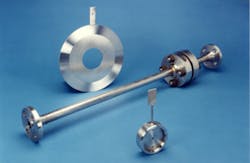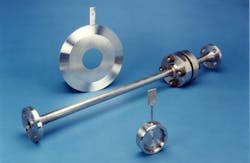Flowmeters can be split into two categories based on when they were released for public use — those released on the market before World War II and those released after World War II. The “old school” pre-WWII meters include diffential pressure (DP), open channel, positive displacement, turbine, and variable area. And while these meter types have been in use for many years, they’re bringing some new technology advancements to certain key application environments. Traditional technology flowmeters will be the topic of a more in-depth article on flow measurment trends in the June 2013 issue of Flow Control magazine. For now, here are five Things to Know About “Old School” Flowmeters based on the content of this soon-to-be published feature article.
- Differential-pressure flowmeters: One of the most important developments in pressure transmitters with implications for flow has been the development of multivariable pressure transmitters. Multivariable transmitters measure two or more process variables. In the context of flow, they have differential-pressure capability, which allows them to compute volumetric flow. In addition to this measurement, they contain a pressure and temperature sensor and/or transmitter to make a temperature and/or pressure measurement. Multivariable pressure transmitters that measure differential pressure, temperature, and gauge or absolute pressure can compute mass flow.
- Variable-area flowmeters: One important development for variable area flowmeters is the development of meters with a transmitter output. The HART protocol is available on some meters. This turns the VA meter into more than a visual indicator, and makes it possible to do control and recording.
- Positive-displacement flowmeters: One of the main uses today for PD meters is for gas utility billing applications. There are two main types of PD meters used for this purpose—diaphragm meters and rotary meters. Rotary meters are replacing diaphragm meters in many cases. Rotary meters are smaller and lighter than diaphragm meters. This replacement is occurring for other gas applications as well.
- Turbine flowmeters: The first turbine flowmeter was invented by Reinhard Woltman in 1790. This makes turbine the earliest meter invented among the flowmeters used in the modern era. Turbine meters precede DP flowmeters by at least 100 years.
- Open-channel flowmeters: Open-channel flow occurs when liquid flows in a conduit or channel with a free surface. Rivers, streams, canals, and irrigation ditches provide examples of open channel flow. What is slightly confusing about this terminology is that that the flow of liquids in partially filled pipes, when not under pressure, is also considered open-channel flow. For example, water flowing through a culvert running underneath a street is considered open-channel flow.
RELATED: A Look at Recent Developments in New-Technolgy Flowmeters
Jesse Yoder, Ph.D., is president of Flow Research Inc. in Wakefield, Mass., a company he founded in 1998. He has 25 years of experience as an analyst and writer in process control. Dr. Yoder specializes in flowmeters and other field devices, including pressure and temperature products. Dr. Yoder can be reached at [email protected].
For more information on Flow Research’s Volume X: The World Market for Flowmeters, 4th Edition study, visit www.floweverything.com.



